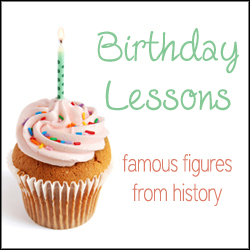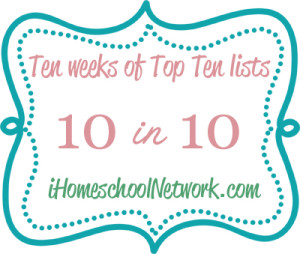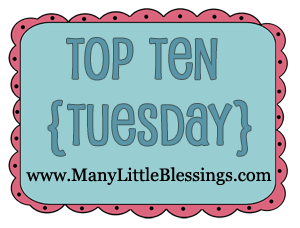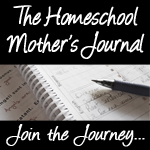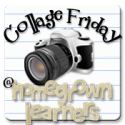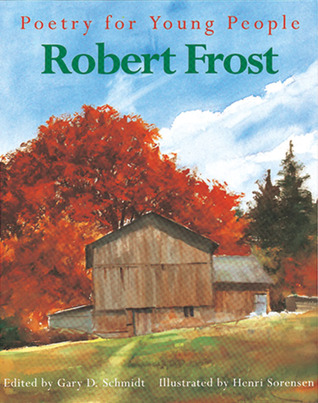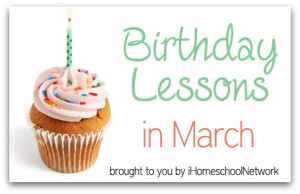 Hi, I'm Heidi and I homeschool my two sweet kids. I want them to know that learning is an exciting lifelong adventure! We love great books, unit studies, notebooking, lapbooking, and hands-on learning.
Hi, I'm Heidi and I homeschool my two sweet kids. I want them to know that learning is an exciting lifelong adventure! We love great books, unit studies, notebooking, lapbooking, and hands-on learning.How I Teach Language Arts Using an Eclectic Lifestyle of Learning
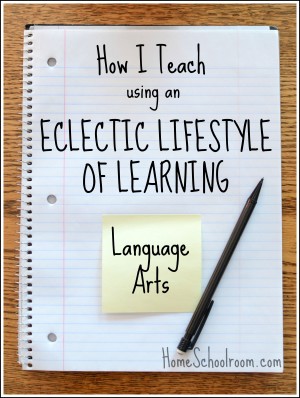
Yesterday I introduced our family and philosophy, now it’s time to move into the nitty gritty: how do we DO this thing called homeschooling? Today the topic is language arts.
Language arts: the subjects (as reading, spelling, literature, and composition) that aim at developing the student’s comprehension and capacity for use of written and oral language.” Miriam-Webster.
Whatever path my children choose in life, the ability to communicate effectively through written and spoken language is fundamental. Grab a cup of coffee, because with such a broad–and important–area of education I’m bound to get a bit wordy!
Before I start, let me tell you the books with the most impact on my teaching style in language arts. Though I do own the original Charlotte Mason homeschooling series (which you can read free here), A Charlotte Mason Companion by Karen Andreola has helped me implement CM philosophy. Two books by Ruth Beechick have also had a great influence on my homeschool instruction: The Three R’s and You Can Teach Your Child Successfully. (I reviewed both of them on The Curriculum Choice.)
Reading and Literature
My eleven-year-old daughter was already a tremendous reader when I began homeschooling her in third grade. We’ve simply continued lots of independent reading and reading aloud. I am happy with how we’ve arranged what she is reading. She must read one chapter daily in a book from a literature list. I created the list with more books than necessary so she has some choice. She can choose free reading books from Honey for a Child’s Heart and Read for the Heart. That way I feel confident the content will feed her soul, and it’s far better than looking on the library shelves and choosing by cover.
My eight-year-old son did not take to reading as quickly as my daughter, but is coming along very nicely. He finished Funnix last year, so this year our plan is simple: read. He reads to me every day as we cuddle on the couch, and I still read aloud a lot to both my children. If we need a little backup in any area, it’s Ruth Beechick’s The Three R’s to the rescue. Her methods are practical and natural.
One thing that I’ve already mentioned twice but I want to stress again: reading aloud. Not only is it a great source of enjoyment, but I believe the patterns of language and wonderful vocabulary are soaked in through listening to literature read aloud, especially books that would be far above their reading level.
Lastly, we meet with one other homeschool family for a very informal book club. All of us read the same book and record our thoughts in a journal, then we get together to discuss the book.
Spelling & Grammar
My plan in spelling and grammar is based on ideas from Charlotte Mason and Ruth Beechick. I don’t use a formal curriculum, but prefer customized instruction by working on issues within their writing. My son is only eight so his writing is limited (I still act as a scribe for his narrations and stories). For my daughter, if I see a word frequently misspelled we’ll add it to a list and work on it for a while. Grammar is also taught within writing. I have several grammar books (I reviewed Nitty Gritty Grammar) we use for reference.
Composition
Though I love the natural methods of Mason and Beechick, I’m also fine with using a formal curriculum at times. Last year my daughter and I worked through WriteShop Junior D and she gained some great skills to add to her writing toolbox. We spent summer and fall without a curriculum, then this winter we’ll try out WriteShop I.
Outside of a formal writing curriculum a lot of writing–letters to friends, notebooking school subjects, stories, a family newsletter, and ideas from my Language Arts Pinterest board. Other than the letters to friends, we edit these together and use them as a quick lesson on anything from misplaced modifiers to word choice.
General Language Arts Skills
Copywork, Dictation and Narration
These natural and powerful techniques are classic Charlotte Mason. I am convinced that regular use is a great tool for expanding skills in both written and spoken language. Ruth Beechick’s books helped with the step by step of using these techniques at each of my children’s specific levels. Though copywork and dictation don’t happen as often as I’d like, narration is a very regular part of our homeschool, especially in history. My daughter writes or types her narrations and we edit them together. I act as a scribe for my son. He can practice organizing his thoughts and use his vast vocabulary without knowing how to spell the words.
Memorizing Poetry
I always loved the idea of memorizing poetry, but hadn’t made an attempt to implement it. Then I listened to a talk by Andrew Pudewa called Nurturing Competent Communicators and realized it wasn’t just a fancy skill to impress the grandparents, but was an opportunity to build a model in their minds of the best use of language. This isn’t a hard and fast subject for us: we find a poem we like, I copy it and post it where we’ll see it frequently. We recite it often and play around with quizzing each other on what comes next. The kids learn them way faster than I do! By the way, I don’t make a rule that they have to be serious classics: Sister for Sale by Shel Silverstein is a favorite.
Latin
I’m putting this in language arts because of the effect it has on the child’s language development with grammar structure and vocabulary. This is where the classical philosophy enters my eclectic mix. We enjoy using Classical Academic Press materials: Latin for Children for my daughter and Song School Latin for my son. With LFC we use it almost exactly as directed, other than taking longer than one week for each chapter–there is a lot of material there! With SSL I do all work orally with my son and don’t require the written work that is available in the student workbook.
Nightly Notes
One area of writing practice that deserves special mention is how my children and I write notes back and forth to each other in a spiral notebook. They write their message to me after I tuck them into bed. Hint: if you have a reluctant writer, the option of staying up a little later to compose a note is a great tactic to encourage writing. I write back sometime during the day. Not only is it fun writing practice where I can easily model correct techniques, but it’s a relationship builder as well.
That’s the lowdown on my language arts teaching. Come back tomorrow for the scoop on how I teach math. The good news is I don’t think it will be half as long as this post!
The “How I Teach” Series:
- Our Family and Philosophy
- How I Teach Language Arts (You just read that one!)
- How I Teach Math
- How I Teach Science
- How I Teach History
- How I Teach Fine Arts
Poet Study: T.S. Eliot
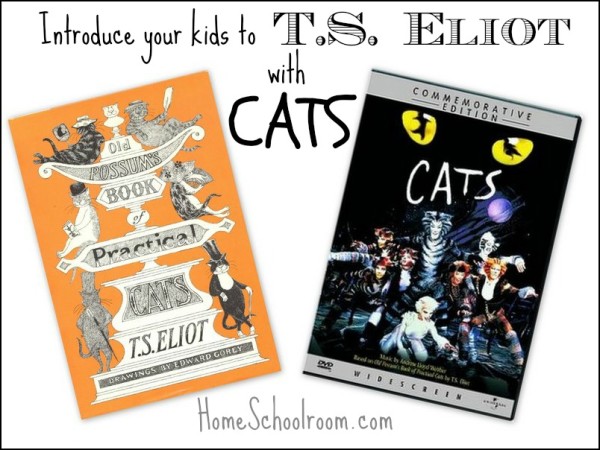
Introduce your kids to the poetry of T.S. Eliot with CATS! September 26th is his birthday, so it’s a great time to share this famous poet with your children.
The Amazon links are affiliate links.
Who is T.S. Eliot?
Thomas Sterns Eliot was born in America in 1888 but settled in England as an adult. He began publishing poems as a college student and went on to be one of the world’s best known poets. He died in 1965. You can read a biography from the Academy of American Poets.
T.S. Eliot Wrote Poems About Cats?
At first I feared my children were too young to enjoy his work, but then I ran across a copy of his book of poetry called Old Possum’s Book of Practical Cats. These poems about cats were written in the 1930s by Eliot in letters to his godchildren (using the name Old Possum). Later they were published in book form. We are owned by a Siamese cat and enjoy reading about cats with personality, so this book was a perfect fit for my kids.
The poems introduce amazingly creative feline characters. Mr. Mistoffelees (the magician), Rum Tum Tugger (who like our cat, “doesn’t care for a cuddle but he’ll leap on your lap in the middle of your sewing”), Mungojerrie and Rumpelteazer (a troublesome duo: ” down from the library came a loud ping from a vase which was commonly said to be Ming”), Bustopher Jones (who is “remarkably fat”), Macavity the villain, and more.
Poetry Inspires a Musical
The fun part is that T.S. Eliot’s book of cat poetry inspired the musical Cats. That’s right, Eliot’s poems were the inspiration for Andrew Lloyd Webber’s famous musical that made history playing on Broadway nearly 18 years! Fortunately you can enjoy a special production of Cats performed by a star cast on DVD.
Note: The dancers are mostly in tight leotards, as is typical for productions we’ve seen like the Nutcracker, but the dancing is decidedly different. For instance, there are video close-ups of Rum Tum Tugger’s Elvis-esque hip gyrations. I just wanted to forewarn you. When we started watching it I thought perhaps this wasn’t my greatest idea, but I’m glad we continued to watch and learn more about this iconic theater production.
If you have this DVD be sure to watch the section called “The Making of Cats.” It has interviews with some of the cast, Andrew Lloyd Webber himself, and many of the other people that brought the show to life for film. The work behind the scenes, from performing the music and dance just so to hand washing costumes and applying makeup is fascinating. The discussions about the very beginnings of the Cats musical and the characters and how they combine human and feline characteristics helped us understand, and thus enjoy, the show more. There is a storyline woven throughout, and I didn’t grasp all of it until we watched the background information.
An interesting story: Andrew Lloyd Webber visited T.S. Eliot’s widow to ask permission to make a musical. She informed him that Eliot had turned down Disney because he didn’t want the cats made into cartoon pussycats. Webber informed her he was thinking more “Hot Gossip” style. According to Wikipedia, Hot Gossip was a British dance troupe known for risque costumes and dance moves. Eliot’s widow says that’s just was he would have wanted!
As you come to know the characters they really grow on you, or at least they did for us. The vocals stay very true to T.S. Eliot’s original poems, and we’ve been singing their tunes around the house since we watched it…therefore my kids are singing lines from a great poet! Wonderful!
Visit the bloggers of iHomeschool Network starting on September 1st for ideas to celebrate other fascinating people born in September.
Scheduling Tea Time for the Extras and 10 Tea Time Snacks
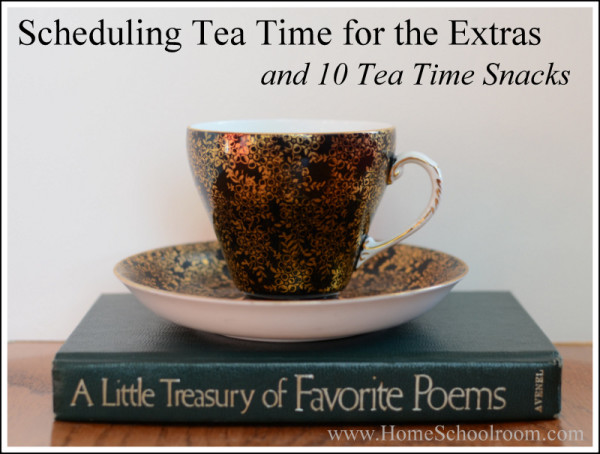
As I’ve been taking the time to reflect on our last school year and iron out what my goals and plans are for next year one thing I’m really excited to institute is a tea time. I’m planning to use it as a time to focus on those lovely “extras” that are a hallmark of the Charlotte Mason style education. We’ll sit down together over a cup of tea and a treat and share poetry and fine art and music.
Anytime I read about other homeschool moms setting aside tea time I liked the idea of making it a special time in our day. Then when I read about Elevenses from Ellen at the Bluestocking Belle I realized the 11:00 time slot would be a good fit for us, too. It will work better than an afternoon tea-time, because often by afternoon we’re either heading to an activity or errands or I’m settling them in for Quiet Time (a daily habit I can’t do without). It also will be a good time to transition between their individual work that starts our day and the subjects we study together.
Step #1 to make this a special time to look forward to in our schedule is having a sweet edible treat. I’m conscious of it being a treat, but not too unhealthy. And although I enjoy baking some days are too busy and I don’t like to have large amounts of sweet baked goods in the pantry (because then I’m tempted to eat them all day long). My answer to those problems are baking things I can freeze. That way we’ll only keep out a little for our tea time and it will also give us variety because every few days we can pull something different from the freezer.
From A to Z here are my go-to freezer-friendly sweet treats I plan to keep stocked for our tea time.
#1 Apple Bread
I use the Apple Walnut Bread recipe from Allrecipes.com, minus the walnuts because my kids don’t like them. I just love the rustic nature of this sweet bread with chunks of apple. I cut the calories a bit by decreasing the oil to 1/2 cup and increasing the applesauce to 1/2 cup. The recipe yields two loaves.
#2 Banana Bread
This recipe comes from an old Canadian cookbook treasured by my mother. I made a few substitutions to make it a bit healthier and everyone still asks for the recipe. This recipe also yields two loaves.
- 2 cups mashed overripe bananas (5-6 bananas)
- 1 1/2 cups brown sugar
- 4 eggs
- 1/2 cup melted butter
- 1/4 cup applesauce
- 1 cup wheat flour
- 2 cups white flour
- 1/2 teaspoon salt
- 2 teaspoons baking soda
- 1 teaspoon vanilla
Mix bananas, sugar and eggs. Add butter, applesauce and vanilla; mix well. Sift together flour, salt and soda. Add to wet ingredients and mix well but don’t over-mix. Bake at 350 degrees for 45 minutes or until a toothpick inserted near the center comes out clean.
#3 Blueberry Muffins
These Blueberry Cream Muffins from Allrecipes.com are a family favorite. I use half brown sugar and half white sugar, and also increase the blueberries to 3 cups (you can add frozen berries right to the batter). It makes 24 muffins so I freeze as many as I can. After thawing I microwave them to make sure they are warm through, then pop them into the toaster oven for a minute–after that you’d swear they were fresh baked.
#4 Cinnamon Raisin Bread
This delicious homemade recipe for Cinnamon Raisin Bread from Allrecipes is a bit more work than most of these treats, but quite delicious. I cut the ingredients in half (because otherwise I think it would overload my Kitchenaid mixer) and it still makes two loaves. It does bake in less than the 45 minutes the recipe calls for, so be sure to check your bread early.
#5 Cranberry Bread
Have you every read Cranberry Thanksgiving? It’s a cute story, and on the back is the recipe for Grandma’s Famous Cranberry Bread. I’d tried several recipes before this that were not what I was looking for–this one is just right–just enough tart cranberry and orange flavor.
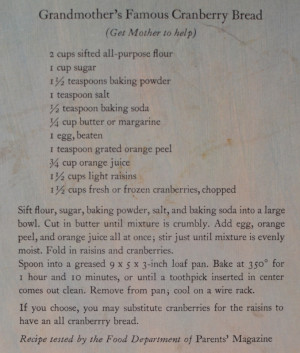
#6 Pumpkin Bread
This recipe for Downeast Maine Pumpkin Bread is terrific. And I’m not saying that just because I’m from Maine–I’m backed up by the 5,000 people who have reviewed it! It makes three loaves, so there is plenty to freeze.
#7 Rhubarb Bread
Every old garden in Maine has rhubarb growing in it. This recipe that was once listed in a local newspaper makes a delicious sweet bread from the tangy stalks.
- 1 1/2 cups packed brown sugar
- 2/3 cup vegetable oil
- 1 egg
- 1 cup buttermilk
- 1 tsp. salt
- 1 teaspoon baking soda
- 1 teaspoon vanilla
- 2 1/2 cups flour
- 2 cups diced rhubarb
Mix brown sugar and oil until smooth. Add egg, buttermilk, salt, soda, vanilla and flour. Blend until moist. Fold in rhubarb. Pour into two greased loaf pans and bake at 350 degrees for 50-55 minutes or until a toothpick inserted near the center comes out clean. (By the way, if you don’t have buttermilk just put one tablespoon of vinegar into a measuring cup, add milk to make 1 cup total liquid and let stand for 5 minutes before using.)
#8 Scotch Tea Muffins
These are plain muffins that are perfect for pairing with homemade jam. The recipe came from an old Canadian cookbook my mother treasures.
- 2 tablespoons butter
- 1 egg
- 4 cups flour
- dash salt
- 1 1/4 cups sugar
- 1 1/4 cups milk
- 4 teaspoons baking powder.
Mix dry ingredients. Then add wet ingredients. Bake at 350 degrees fro 15-20 minutes.
#9 Whole Wheat Bread
I love this Simple Whole Wheat Bread recipe from Allrecipes.com. It makes three loaves so the work involved really pays off and I’ve had wonderful luck with it. When I first started making it I tried freezing the dough before it rose at all, freezing after the first rise and freezing after it was baked. The already baked bread tasted wonderful from the freezer and the bonus: that was the easiest, too, because it can be taken right out of the freezer, thawed and enjoyed just like fresh baked. If anyone has frozen store-bought bread before you may notice the texture suffers after you thaw it. This is not the case with homemade bread–trust me!
#10 Zucchini Bread
And last, but certainly not least, a recipe for Zucchini Bread from Allrecipes.com. If your children balk at the idea just feed it to them first before you tell them what’s in it. My children love this bread.
What Will We Do During Tea Time?
- We’ll read poetry aloud with a goal of memorizing one poem each month.
- Homeschool Share has regular Tea Time posts with information and links for studying poets, composers, and artists.
- These next two resources have helped expose and educate me along with my children in subject areas that were challenging for me. I had almost no experience or knowledge in fine art and music and these resources from fellow homeschool moms are invaluable.
- Fine art and music appreciation is planned for you with Harmony Fine Arts. We’ll be using Grade 5 this year to go along with our history studies.
- Mary from Homegrown Learners shares her classic music appreciation technique of Super Quiet UnInterrupted Listening Time. I’m an affiliate for her just-released ebook with 10 SQUILT lessons because I honestly love this resource. The information she shares on each piece of music is crucial for me to share intelligently with my children. Click here to visit Homegrown Learners.
Hop over to iHomeschool network for more top ten lists.
This blog hop series was inspired by Angie of Many Little Blessings where you’re welcome to link up, too!
Picture Books That I Just Can’t Part With!
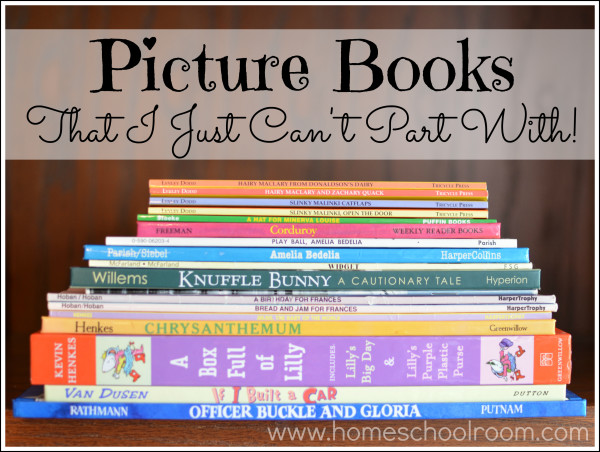
There are the picture books that I just can’t part with, even though both my kids are well past picture book age. Nobody asks me to read the same stories over and over at bedtime anymore, but certain books are here to stay.
Oh, the memories in these books! I stacked all our favorites on the kitchen table. My criteria to begin with was that both my daughter and son had loved the book, and it was enjoyable to read. (You know, not one of those books you hide on the bottom of the stack because you just can’t bear to read it again.)
The kids and I worked together to narrow it down. Choosing our favorite books is a bit like choosing among our friends, but this is a top ten list so I had to make some tough choices. I even cheated, by lumping some series and author favorites together. I just couldn’t help myself!
The book links are Amazon affiliate links. Using those links doesn’t affect your price but helps my bottom line. Thanks!
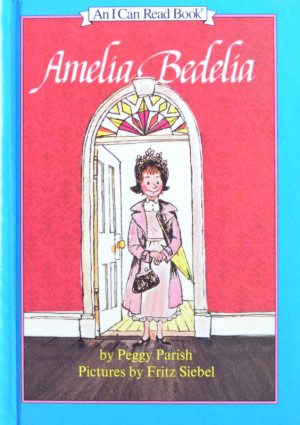
1. Amelia Bedelia by Peggy Parish
I clearly remember choosing Amelia Bedelia books from our school library growing up, and I had such fun sharing this delightful character with my children. We love to notice Amelia-Bedelia-type directions that could confuse someone.
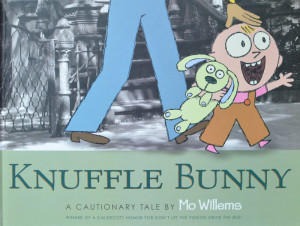
2. Knuffle Bunny: A Cautionary Tale by Mo Willems
There is so much to love about this book! One is the creative illustrating style of black and white photos with cartoon images on top. If your children have a special stuffed animal they’ll enjoy the story of Trixie losing her Knuffle Bunny. Everyone laughs at the page where Trixie goes “boneless” to show her displeasure.
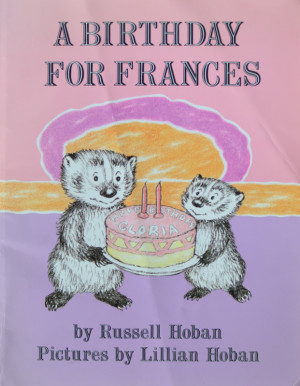
3. Frances books by Russel Hoban
Frances books are another flashback from my childhood. She’s a wonderful character with common childhood woes (jealously over a new baby sister or that baby sister’s birthday, fear of trying new foods) and a penchant for making up silly songs. A Birthday For Frances is one of our favorites because of the song “Happy Chompo to Me.”
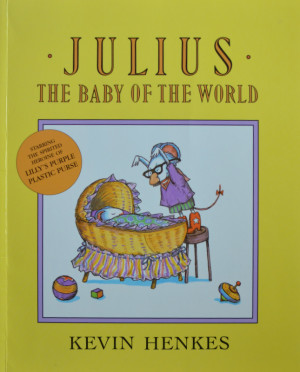
4. Julius The Baby of the World by Kevin Henkes
This book is a must read for children with new siblings. Lilly’s antics after the arrival of her new baby brother are laugh-out-loud funny, and of course there is a happy ending. We adore so many of Kevin Henkes books: Lilly’s Purple Plastic Purse, Lilly’s Big Day, Chrysanthemum, Weekend with Wendell, and Wemberly Worried.
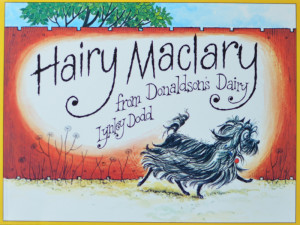
5. Hairy Maclary and Slinky Malinki books by Lynley Dodd
The rhyming text and illustrations in these books by Lynley Dodd are endearing. There are several books featuring the skittish pup Hairy Maclary and black cat Slinky Malinki. Our favorite character appears in most titles: Scarface Claw, the “toughest tom in town.” Prepare to hiss and spit as you read the stories which leads to lots of giggles.
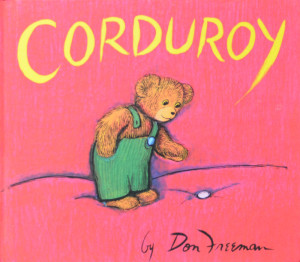
6. Corduroy by Don Freeman
I’m sure this beloved story of a little teddy bear looking for his lost button would make many people’s lists. The happy ending is perfect for sappy book lovers like me. We also love Earl the Squirrel by the same author, an adorable story of a squirrel learning to be independent.
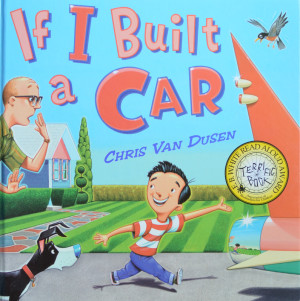
7. If I Built a Car by Chris Van Dusen
Chris Van Dusen is a Maine author and illustrator. This book highlights his wonderful rhyming text and incredible illustrations with a story of one boy’s creative car design. The Mr. Magee series by Chris is also lovely and features silly Mr. Magee and his pup on some pretty wild adventures.
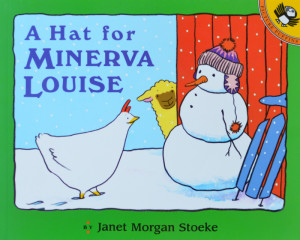
8. Minerva Louise by Janet Morgan Stoeke
If we ever get chickens one of them is sure to be named Minerva Louise. Minerva Louise isn’t happy to stay in the coop like the other chickens and this series contains simple text and pictures that show the zany misunderstandings of this quirky chicken. We’ve enjoyed all the titles: A Hat for Minerva Louise, Minerva Louise and the Red Truck, Minerva Louise on Halloween, and Minerva Louise and the Colorful Eggs.
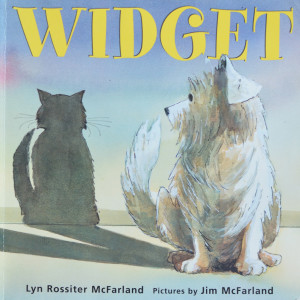
9. Widget by Lyn Rossiter McFarland
Widget is a homeless dog who finds a home in a house full of cats. It’s a great story, especially if you love dogs and cats. You’ll enjoy Widget’s attempts to act like a cat.
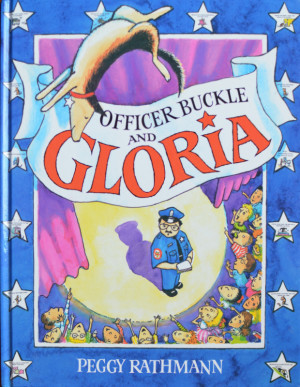
10. Officer Buckle and Gloria by Peggy Rathmann
Another great story for dog lovers, this book is about Officer Buckle, a safety-obsessed officer who gives lectures on safety rules at schools. He gets a new dog, Gloria, and she enlivens his lectures with hilarious behind-his-back antics. When he first finds out that’s why he’s so popular Officer Buckle is pretty upset, but later learns the very important rule “Always Stick With Your Buddy!”
Do you have a collection of books you can’t part with even though your kids have outgrown them? What are some of your favorite picture books?
Hop over to iHomeschool network to see more top ten book lists. Every Tuesday for the next 10 weeks I’ll be participating with the other bloggers of iHN in a blog hop of top ten lists.
This blog hop series was inspired by Angie of Many Little Blessings where you’re welcome to link up, too!
A Beautiful Moment
We were in the basement of our small town library for the once a week book sale. My ten year old daughter and her dad were perusing a small wooden bookshelf with old books.
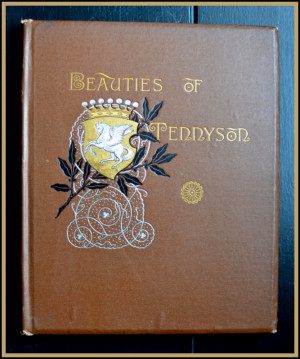
She brought one over to show me because of the beautiful cover. As we read the title, Beauties of Tennyson, both our eyes widened.
Backtracking a bit: we recently finished the Little House series. Those stories have become part of the fabric of our family and we were sad to be done living Laura’s life through her books.
It was a perfectly new book, beautifully bound in green cloth with a gilded pattern pressed into it. The smooth, straight, gilt edges of the pages looked like solid gold. On the cover two curving scrolls of lovely, fancy letters made the words: Tennyson’s Poems.
~From Little Town on the Prairie by Laura Ingalls Wilder
We carefully opened the cover to check the date: 1885…Laura’s time period! My daughter opened it and found “Song From Maud.”
Laura tried to read again her favorite of Tennyson’s poems:
Come into the garden, Maud,
For the black bat, night, has flown,
Come into the garden, Maud,
I am here at the gate alone;
And the woodbine spices are wafted abroad
And the musk of the rose is blown.
~From Little Town on the Prairie by Laura Ingalls Wilder
My daughter’s face flushed as she gingerly held the book in her hands. “You have to get that book,” I said. She left the proud owner of Beauties of Tennyson.
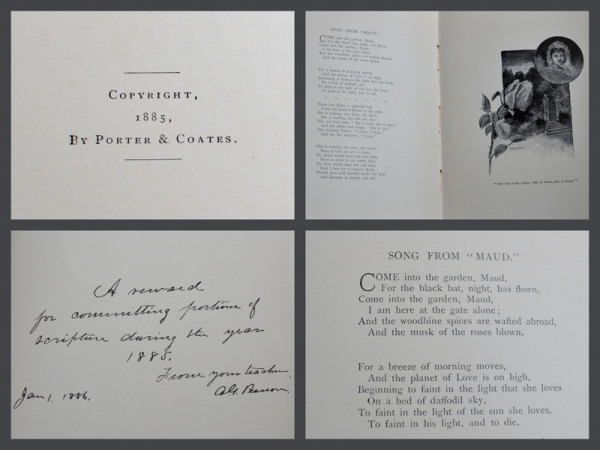
Isn’t it beautiful? Look at the dedication:
A reward for commiting portions of scripture during the year 1885.
From your teacher,
[teacher’s name]
Jan 1, 1886.
What else did we do this week? A lot. Outside engagements every day. Too many errands. Reading, writing and arithmetic. There are times I feel I’m not managing it all very well. We rarely get all the schoolwork I planned crossed off my list. The house gets far too messy. I’m often trying to figure out what’s for dinner at 4 pm. I snap at the people I love most.
But this moment in the basement of the library was perfect.
My growing-up-way-too-fast little girl had tears in her eyes over a 128 year old book of poetry. I must be doing something right. Sharing quality literature, poetry, and music is having an impact on their lives, now and hopefully forever.
I’m going to store this memory, dwell on it, and let it overshadow other less-than-perfect moments.
I’m linking up–click over and see what other homeschoolers are doing.
Poet Study: Robert Frost
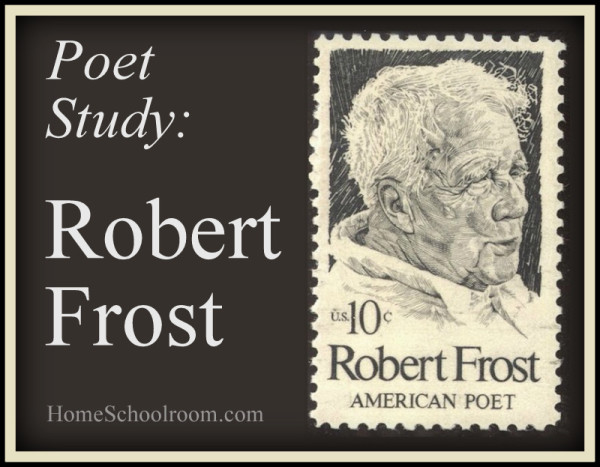
I read poetry to my children regularly. Sometimes I share poems from anthologies and sometimes poems related to the season, holiday, or our studies in nature or history. Other times we focus on one poet, and March is a great month to enjoy a study of Robert Frost, who was born on March 26th, 1874.
Other than the fact that it’s his birthday, and that he’s one of America’s best-loved poets, what homeschooler doesn’t identify with these famous lines:
Two roads diverged in a wood, and I–
I took the one less traveled by,
And that has made all the difference.
~from “The Road Not Taken” by Robert Frost
Getting to Know Robert Frost
Born and raised in Maine, I feel a special connection to his poems depicting scenes of rural New England life. I was amused to find that he was actually born in California! He moved to New England (where his family was from) when he was 11.
Although he was writing poems as a young adult he was not able to support himself as a poet until much later in his life. In the meantime he wrote for newspapers, taught, and farmed (though not very successfully). It wasn’t until he moved to England in his late 30s that his work was accepted by a publisher in Britain. He moved back to America, and ten years after his first book of poetry was published he won the first of four Pulitzer prizes.
Poetry for Young People: Robert Frost has a short biography of the poet. This biography online also has nice information about not just his poetry but also his personal life. I find his life story interesting and worth sharing with my children: there is a lesson to be learned about following your passion even if you aren’t immediately successful.
Getting To Know Robert Frost’s Poems
I can’t recommend the Poetry for Young People series highly enough. With the story of the poet at the beginning, and then a selection of poems with accompanying artwork, it is worth adding to your bookshelf. I also appreciate the notes at the bottom of the page that help explain the theme or style of the poem.
Several of his poems have been made into picture books–a perfect way to introduce his poetry to younger children and enjoyed by all ages in our home:
Here are some free resources for enjoying his poetry:
- There are links to many of his poems on the right sidebar at The Academy of American Poets website.
- Librivox has a free audio download of eight poems.
- You can also watch a video of Frost reading “Stopping By Woods on a Snowy Evening.”
Adding the Extras
Reading about the poet and sharing his poems can stand alone, but you can further the learning (or just the fun) by adding in any of these enrichment ideas.
- Jimmie has perfect Robert Frost Notebooking Pages over at the Notebooking Fairy.
- Use one of his poems for copywork.
- Have your child memorize their favorite Frost poem.
- Print a poem and have your child illustrate it.
- The chalk pastel tutorials Tricia posts at Hodgepodge are one of my favorite art resources! Several would go well with the scenes of nature in many Robert Frost poems: To The Woods, Tree Silhouette, Apple, Old Shed in the Snow.
- According to the Robert Frost Farm website, the Frost family served banana pudding topped with chocolate syrup and whipped cream at birthday parties. I’m always game to add food to our studies!
Hop on over and check out other unit studies of fascinating people born in March from the bloggers of iHomeschool Network!
Funnix Reading Program Review
My primary goal for my Kindergarten son was to learn to read. As a homeschooler who bases much of our curriculum around quality books, I felt strongly that reading skills are paramount and the best thing I could do to equip him to be a life-long learner. I also knew we would need all the help we could get! Like many boys he is wiggly, silly, and more interested in trucks and Legos than letters and sounds.
You can head over to read my review of the Funnix Reading Program at The Curriculum Choice.
Why I Was Wrong About the Kindle
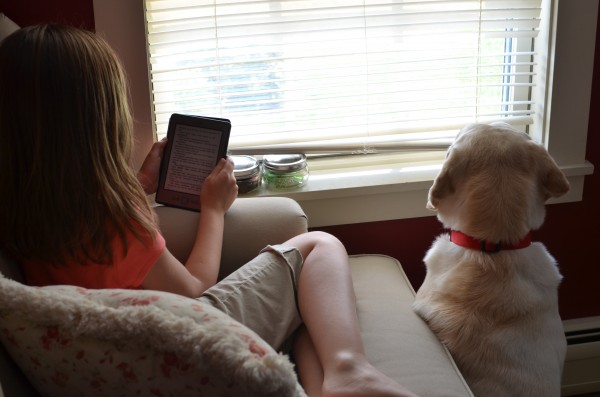
Conversations about incorporating new technology, be it software or hardware, in our house often go something like this:
My husband, fondly known as Mr. Tech Support: “Hey Heidi, I think you (or the kids) could benefit from [insert name of new technology here].”
Me: “No, no, I don’t think we need any new technology. In fact, there’s too much technology around here…whatever happened to the good old days where families grew all their own food and everyone sat around the wood stove at night? Those were simpler times. By the way, I’m thinking about getting chickens.”
Being the supremely patient husband that he is, he’ll just nod and smile. If he really thinks we should try it he’ll have a go at talking me into it again after I’m done looking at chicken coop plans online. This is when I launch into my litany of reasons why [insert name of new technology here] is actually evil. Again, he’ll smile smile and nod.
And…inevitably he’s right. I have fought everything from online banking to Google calendar to smartphones, all things I now couldn’t live without. Where does this fear come from? Maybe it’s hereditary: his grandmother was on Facebook and played poker on line while my grandmother never owned a computer. Perhaps I come from a long line of people with new-technology-phobia. Lucky for me (and my kids) I married a tech guru and he holds my hand all the way.
Back to the reason for this post: the Kindle. I fought this one for months and I felt like I’d accrued a pretty good list of reasons against getting one for our 10 year old daughter. Same routine: he’d mentioned it several times, I didn’t even research it but just said it was evil and would mean the death of all books (or something like that). I had my reasons against it and, as usual, it turns out I was completely wrong.
Reason number one (I was really proud of this one and used it first whenever the topic arose): “Oh, the eye strain!” This one is completely false. I had to see one in real life to be astounded by how an electronic screen can look just like a piece of paper. It doesn’t glow or have lighting or look like an iPad screen. It causes no more eye strain than reading a paper book for hours on end–something I was prone to do as a child.
My back-up reason: She won’t be reading real books, or quality literature. I was really off here. Okay, so it won’t be a paper book, but they are real books. And once we download them from most sources she can keep them on her kindle (it can store over a thousand books) so she can re-read them anytime. And here was the kicker: many older classic books are FREE so we were able to load her Kindle up with the good stuff. She’s already finished two classics that were on the list of books I wanted her to read. She is reading even more and instead of picking the newest looking book with a cute cover design at the library she’s picking up a classic. Bonus good point: she likes reading several books at once. With the Kindle she can bring those books with her camping or anywhere we go while taking up almost no space.
The last selling point, and something I hadn’t been open-minded enough to research and figure out, was the built-in dictionary. Yes, it’s valuable to be able to look up words in a paper dictionary, but who stops while reading a good book to do that? Well, on her kindle she just places her cursor over a word and sees the dictionary definition. She’s been telling us the meaning of words she has looked up, and we’re making it into a casual “word of the day” routine where she picks one for us all to try and use.
So, I was wrong. She’s not walking around with bloodshot eyes. She’s actually reading great books and enlarging her vocabulary all the while. Score another one for Mr. Tech Support.
